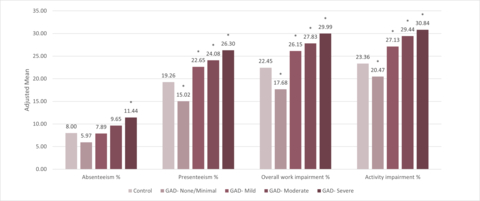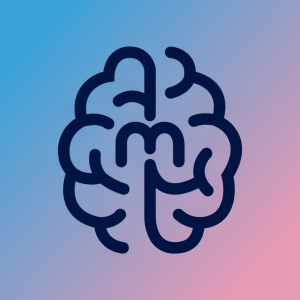New Studies Presented at the International Society for Health Economics and Outcomes Research Meeting (ISPOR 24) Show Growing Burden and Impact of Generalized Anxiety Disorder (GAD) in the US
MindMed presented new studies at ISPOR 24 revealing the significant impact of Generalized Anxiety Disorder (GAD) in the US. The studies showed that GAD diagnosis increases healthcare costs, decreases work productivity, and diminishes health-related quality of life. Undiagnosed GAD patients incur even higher healthcare costs. MindMed is investigating new treatments for GAD and other brain health disorders.
- None.
- None.
-GAD Diagnosis Increases Healthcare Costs and Decreases Work Productivity and Health-Related Quality of Life-
-People with Undiagnosed GAD Incur Even Higher Total Healthcare Costs than those Diagnosed with GAD-
-Comprehensive Analyses of GAD Disease Burden in the US Conducted by MindMed; Company is Investigating New Treatments for GAD and Other Brain Health Disorders-

Figure 1. Work Productivity: Absenteeism, presenteeism, overall work productivity loss and activity impairment: GAD by symptom severity vs. controls. Note: Groups that were statistically significant at p0.05, 2-tailed, compared with controls are marked with asterisks. Absenteeism, Presenteeism, and Overall work impairment were only applicable to those indicating they were currently working for pay. Absenteeism was not calculated for those who worked 0 hours and missed 0 hours in the last 7 days, and presenteeism was only asked among those who worked >0 hours in the last 7 days. (Abbreviations: GAD: generalized anxiety disorder.) (Graphic: Business Wire)
Three studies examined the impact of GAD on healthcare utilization and costs, workplace productivity, and healthcare quality of life (HC QOL). All three studies demonstrated that the economic and societal impact of GAD is substantial, gets worse when anxiety symptoms are more severe, and is more significant when GAD is present but undiagnosed.
“These studies clearly demonstrate that the burden of GAD on the US healthcare system, employers, and people living with GAD is enormous. We continue to discover evidence that the impact of GAD has been underappreciated and that people living with this disorder are underserved,” said Daniel R. Karlin, MD, MA, Chief Medical Officer of MindMed and senior author of these studies. “We undertook these studies as part of our commitment to highlight the scale of the anxiety crisis and our mission to address this burden. The results of these in-depth analyses speak for themselves.”
The studies were conducted using data from the 2022 National Health and Wellness Survey (NHWS; N=75,261). The NHWS is an annual internet-based survey; all data are self-reported. Recruitment is designed to represent the general US adult population in terms of age, race, ethnicity and gender distribution. Participants were requested to use the clinically validated GAD-7 screening tool as recently recommended by the US Preventive Services Task Force (USPSTF).
Three studies were presented at ISPOR 24:
- Work Productivity and Activity Impairment Associated with Generalized Anxiety Disorder among Adults in
- Health Care Resource Use Associated with Generalized Anxiety Disorder among Adults in
- Health-related Quality of Life Associated with Generalized Anxiety Disorder among Adults in
Key Findings from MindMed HEOR Studies
Work Productivity (see Figure 1)
-
Compared with controls (
8.0% ,95% CI:7.6% -8.4% ), absenteeism was statistically significantly higher among the severe Diagnosed GAD group (11.4% ,95% CI:8.4% -15.5% ) (p=0.03) and increased as severity worsened among adults diagnosed with GAD (none:6.0% ,95% CI:4.5% -8.0% , mild:7.9% ,95% CI:6.2% -10.1% , moderate:9.6% ,95% CI:7.3% -12.8% , severe:11.4% ,95% CI:8.4% -15.5% ). -
Compared with controls (
19.3% ,95% CI:18.8% -19.7% ), presenteeism was significantly higher among the mild, moderate, and severe Diagnosed GAD groups (22.6% -26.3% ) and increased as severity worsened among adults diagnosed with GAD (none:15.0% ,95% CI:13.0% ,17.4% , mild:22.6% ,95% CI:20.1% -25.6% , moderate:24.1% ,95% CI:20.8% -27.8% , severe:26.3% ,95% CI:22.5% -30.7% ). -
Compared with controls (
22.5% ,95% CI:22.0% -22.9% ), overall work productivity impairment was statistically significantly higher among the mild, moderate, and severe Diagnosed GAD groups (26.1% -30.0% ) and increased as severity worsened among adults diagnosed with GAD (none:17.7% ,95% CI:15.4% -20.3% , mild:26.1% ,95% CI:23.3% -29.3% , moderate:27.8% ,95% CI:24.3% -31.9% , severe:30.0% ,95% CI:25.9% -34.7% ).
Healthcare Resource Use (HCRU) (see Figure 2)
- Diagnosed GAD patients had an adjusted average of 3.1 HCP visits, 0.31 ER visits, and 0.19 hospitalizations within the past 6 months.
- Undiagnosed people who screened positive for GAD (using the USPSTF-recommended GAD-7 screening tool) had an adjusted average of 2.2 HCP visits, 0.51 ER visits, and 0.36 hospitalizations within the past 6 months.
-
Compared with the diagnosed GAD group, the undiagnosed GAD group had significantly lower rates of HCP visits (IDR: 0.71,
95% CI: 0.66-0.77, p<0.01). -
However, those with undiagnosed GAD were 1.64 times more likely to have an ER visit (
95% CI:1.42-1.90) and 1.95 times more likely to have a hospitalization (95% CI: 1.59-2.40) than the diagnosed GAD group, suggesting significantly greater HCRU among the undiagnosed group (both p<0.01). - Those with no GAD diagnosis who screened negative for GAD (No-GAD) had an adjusted average of 2.0 HCP visits, 0.26 ER visits, and 0.18 hospitalizations within the past 6 months.
-
Compared with the diagnosed GAD group, the no-GAD group had significantly lower rates of HCP visits (IDR: 0.64,
95% CI: 0.59-0.68, p<0.01). -
Compared with the diagnosed GAD group, the no-GAD group had significantly lower rates of ER visits (IDR: 0.84,
95% CI: 0.73-0.96, p=0.01) and similar hospitalization rates (IDR: 0.97,95% CI: 0.80-1.19).
Health-Related Quality of Life (HR QOL) (see Figure 3)
-
Compared with controls (45.3,
95% CI: 45.2-45.4), adjusted Global Health Composite (GHC) scores were significantly lower among the mild, moderate, and severe Diagnosed GAD groups (35.0-41.5). -
Adjusted GHC scores decreased as severity worsened among adults diagnosed with GAD (mild: 41.5,
95% CI: 41.0-42.0, moderate: 38.3,95% CI: 37.8-38.9, and severe GAD: 35.0,95% CI: 34.4-35.6). - A similar trend was observed for Mental Health Composite (MHC) and Physical Health Composite (PHC) scores.
- The magnitude of the difference in MHC scores was larger than the difference observed in PHC scores, suggesting a greater impact of GAD symptom severity on mental health functioning than physical health functioning.
“From my perspective, one key takeaway from our research is the significant and increasing impact of GAD on work productivity, which should concern employers and payers,” according to the lead author of the studies, Phong Duong, PharmD, Vice President of Global Market Access, Health Economics and Outcomes Research at MindMed. “The other key finding was that people with undiagnosed GAD may actually cost more to manage in terms of overall healthcare resource utilization than those who have been diagnosed, which strongly supports screening the general population for GAD using the clinically validated GAD-7 screening tool as recently recommended by the US Preventive Services Task Force (USPSTF).”
About Generalized Anxiety Disorder (GAD)
GAD is a common condition associated with significant impairment that adversely affects millions of people. GAD results in fear, persistent anxiety, and a constant feeling of being overwhelmed. It is characterized by excessive, persistent, and unrealistic worry about everyday things. Approximately
About MindMed
MindMed is a clinical stage biopharmaceutical company developing novel product candidates to treat brain health disorders. Our mission is to be the global leader in the development and delivery of treatments that unlock new opportunities to improve patient outcomes. We are developing a pipeline of innovative product candidates, with and without acute perceptual effects, targeting neurotransmitter pathways that play key roles in brain health disorders.
MindMed trades on NASDAQ under the symbol MNMD.
Forward-Looking Statements
Certain statements in this news release related to the Company constitute “forward-looking information” within the meaning of applicable securities laws and are prospective in nature. Forward-looking information is not based on historical facts, but rather on current expectations and projections about future events and are therefore subject to risks and uncertainties which could cause actual results to differ materially from the future results expressed or implied by the forward-looking statements. These statements generally can be identified by the use of forward-looking words such as “will”, “may”, “should”, “could”, “intend”, “estimate”, “plan”, “anticipate”, “expect”, “believe”, “potential” or “continue”, or the negative thereof or similar variations. Forward-looking information in this news release includes, but is not limited to, statements regarding the prevalence of undiagnosed GAD patients; the cost of treating GAD patients; the potential impact of GAD on productivity; and the potential benefits of the Company’s product candidates. There can be no guarantees regarding the results of the potential Phase 3 clinical trial or that, following any such trial, MM120 will receive the necessary regulatory approvals. There are numerous risks and uncertainties that could cause actual results and the Company’s plans and objectives to differ materially from those expressed in the forward-looking information, including history of negative cash flows; limited operating history; incurrence of future losses; availability of additional capital; lack of product revenue; compliance with laws and regulations; difficulty associated with research and development; risks associated with clinical trials or studies; heightened regulatory scrutiny; early stage product development; clinical trial risks; regulatory approval processes; novelty of the psychedelic inspired medicines industry; as well as those risk factors discussed or referred to herein and the risks described in the Company’s Annual Report on Form 10-K for the fiscal year ended December 31, 2023, under headings such as “Special Note Regarding Forward-Looking Statements,” “Risk Factors” and “Management’s Discussion and Analysis of Financial Condition and Results of Operations,” and other filings and furnishings made by the Company with the securities regulatory authorities in all provinces and territories of
View source version on businesswire.com: https://www.businesswire.com/news/home/20240509733055/en/
For Media Inquiries, please contact: media@mindmed.co
For Investor Inquiries, please contact: ir@mindmed.co
For Medical Inquiries, please contact: medaffairs@mindmed.co
Source: Mind Medicine (MindMed) Inc.
FAQ
What studies were presented at ISPOR 24 by MindMed?
What were the key findings of the MindMed studies on GAD?
What is MindMed investigating in relation to GAD?
What is the stock symbol of MindMed?
Where was the ISPOR 24 conference held?
How was the impact of GAD on healthcare utilization and costs demonstrated in the studies?







